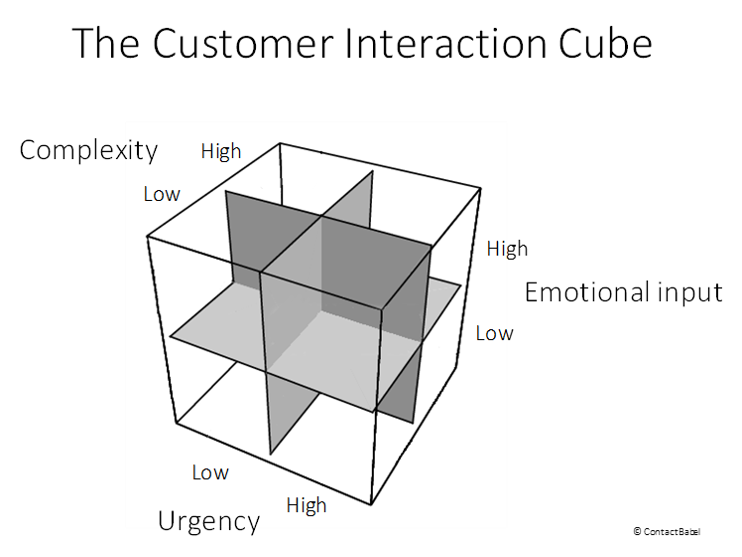For CX, the urgency, complexity and emotional importance of the interaction is perhaps at least as important as the nature of the business that is being called: for a customer calling a bank, a simple balance request and an urgent call about the progress of the mortgage application are very different types of call, and should be treated as such.
The ‘Customer Interaction Cube’ is a structure developed to categorize the different types of customer interactions that businesses have to handle, considering the urgency, complexity and emotional input of the interaction from the customer’s perspective. Businesses could use this to analyse their volumes of each type of interaction, cross-referencing it with other variables such as the time of day these types of interaction are received, and the customer demographic preferences in order to support the relevant channels through the promotion of alternatives to live calls, and the correct levels of resourcing. Doing this will not only improve CX, but also reduce the cost of service through anticipating the likely resourcing required and even proactively engaging with the customer on lower cost channels first, improving first-contact resolution rate, which customers consistently state is their no.1 CX driver.

Using this 2x2x2 cube as a structure, there are eight types of interaction, a combination of either low or high urgency, complexity and emotional input. Our hypothesis is that each of these eight interaction types may best be suited to specific channels, and that both business and customer could benefit from matching channel with interaction type.
The examples shown below of various scenarios and the channels most suitable for these are suggestions, and will differ between customer types, businesses and vertical markets, but may offer a framework for readers to build their own scenarios.
While the 2x2x2 cube
can help businesses to estimate the current and potential volumes and
resourcing required to serve the customer base, it is important to remember
that similar types of customer interaction may require very different handling
depending on circumstances. For example, a query about product delivery may be
a small part of a wide-ranging research process carried out by a particularly
thorough prospective customer, or may be asked by a customer who has just
realized he’s forgotten about an important birthday and needs immediate,
accurate information. There can also be a big difference in how customers of various ages choose to contact a business.
McKinsey talks about
the ‘moment of truth’ in customer interactions,
often occurring when the customer has an unexpected problem or has a high
emotional stake, when long-term loyalty and customer advocacy can be won or
lost depending on the outcome and the way in which it is handled. Businesses
and their representatives should be aware that these relatively rare
occurrences offer great opportunities. Recognizing and handling these moments
of truth appropriately – moments which are defined as such by the customer, not
the business - will have a far greater long-term impact on customer
satisfaction and loyalty than the dozens of competently-handled, forgettable
interactions that may have happened previously.
Although the 2x2x2
cube gives some indication of the types of interaction that are more likely to
be ‘moments of truth’, which businesses may choose to be handled by their more
experienced and empathetic agents, they are by their nature difficult to
predict. Current real-time speech analytics solutions can indicate a measure of
stress in the customer’s voice, flagging this up to the agent within the call,
but agents should be in any case capable of recognizing this without
technology. In any case, if the customer has already tried two or three other
channels without success, even the most competent and empathetic agent will
find it difficult to turn the moment of truth around positively.
Further reading:
This article is based on findings in The UK Contact Centre Decision-Makers' Guide.